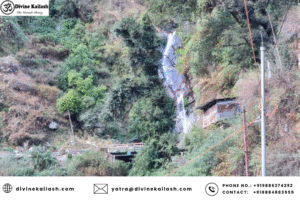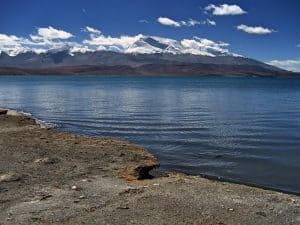Lord Shiva is an integral and intriguing figure of Hindu mythology, and the holy trinity Bharmha, Vishnu and Maheswar. Across India, several temples are dedicated towards the eternal master, among them, the twelve Jyotirlingas are of importance. The Kedarnath Temple nestled amidst lofty snow-covered mountains in the Rudraprayag district of Uttrakhand is the seat of Lord Shiva and one of the twelve Jyotirlingas. Kedarnath Temple is more than 3000 years old and it is mentioned in Mahabharata. The current temple is almost 1200 years old was built by Adi Shankaracharya. This temple is a re-creation of the temple built by Pandavas. An architectural marvel, the temple holds enormous religious significance.
Kedarnath Temple – A preface
Kedarnath is one of the four important shrines of Chardham Yatra of Uttarakhand. Some quick facts about the Kedarnath temple are below.
- Situated in Kedarnath’s holy town, in the bans of river Mandakini, and the Kedarnath Mountain in its back flanks the mysterious river Saraswati, this abode of Lord Shiva.
- The temple is situated at an altitude of 3584 meters, above sea level.
- Every year thousands of tourists conquer chilling cold and rough trek of 16 km from Gaurikund to seek the blessings of Lord Shiva. Shiva is an embodiment of timelessness and eternal devotion and union, the temple elucidates the same. Illuminating the souls and granting freedom from sins, the temple has won over the wrath of nature time and again.
- From forest fires to 2013 floods, the temple stands strong on devotions and divine power pillars.
- The temple opens for pilgrims as the Sun enters the zodiac sign of Aires. This is from April to November.
The mystical architecture of the Kedarnath temple
The Kedarnath temple touches hearts with its holiness, and its architecture intrigues the minds. Set at this high altitude, the temple is built on a large rectangular platform. The temple is built of big blocks of stone, how these blocks were carried to such high altitude in an era that dates back thousands of years is still a mystery. The inner walls of the temple sanctum have a beautiful engraving of the mythological figures and deities. The temple has first is its Mandap, which is for the devotes to gather for darshan, and then there is the ‘Garbha Griha,’ which is where the triangular Shiva Linga is placed. There is the symbolic bull or the Nandi in front of the temple.
The temple’s architecture has always been a subject of awe for architects even in this era, but the 2013 floods made them wonder even more. The devastating floods caused by a cloud burst caused extensive damage to the whole area but the temple was saved almost magically. Call it the divine enchantment, power of devotion, or architectural mastery; the temple proved that it is not to be swayed away. Neither could the flood reduce the enthusiasm of devotes going for Char Dham Yatra.
Inside the temple
As with the exterior, the interior of the temple is equally fascinating. The status of the five Pandava brothers, Draupadi, their wife, Lord Krishna, and other deities, adorn the walls. The rough conical stone is worshipped as the Siva Linga, placed inside the Garbhagriha. It is the Sadashiva form of Lord Shiva. One of the mystical elements of the temple is the head of a man engraved on a stone. The significance of this element is still not known. Char Dham Yatra Uttarakhand is full of many such surprise elements.
What the Legend has?
Temples in India are never without a legend. Mostly from the Vedic ages, the mythological stories enliven the era that holds the roots and the emancipation of divine presence in all-natural elements. The Char Dham also treats with many of such legends.
The story behind the Kedarnath temple is a chapter from Mahabharata. It says that the Pandavas, after winning the war of Kurukshetra against their cousins Kauravas, suffered from the inner guilt of killing their kin. To get renunciation, they looked for the blessings of Lord Shiva. They searched for him at various places on their journey towards heaven, but Shiva unwilling to grant them freedom from their guilt eluded them. He transformed himself into a bull and grounded himself. Later found by Bhima, he promised to stay there at Kedarnath. Actually, the bulls’ hump was found in Kedarnath, the other body parts were scattered in different places called Pancha Kedar. The Pandavas built a temple dedicated to Lord Shiva at Kedarnath. People believe that offering prayers to divine light at Kedarnath attain them moksha or freedom from the sins. Tourists may take Chardham Yatra Packages, for visiting this ancient shrine.
Kedarnath Temple- The rites and rituals
Kedarnath temple is also known for its distinctive rituals worshipping Lord Shiva. Apart from having historical and mythological significance, the temple also has immense cultural significance for modern India. Priests from Karnataka belonging to the Rawal community who are part of the Verra Shaiva Sangam Community of Karnataka perform puja here. Thus the temple also stands as a symbol of north-south unity.
The Rawal or the head priest does not perform the puja himself, his assistants conduct the puja. There are five senior priests in totals, who become head priests for one year in rotation. The puja is carried out in the Kannada language and the same pattern and sequence since the 10th century AD. The Shiva Linga is carried to Ukhimath in winters and brought back to Kedarnath temple by a massive procession on a flower-decked palanquin.
Kedarnath as a part of Char Dham Yatra
Kedarnath can be visited solitary or as a part of Char Dham Yatra, consisting of Kedarnath, Badrinath, Gangotri, and Yamunotri. Kedarnath is one of the most challenging treks among the four dhams. The temple is accessible through trek; people can hire porters who carry pilgrims on their pony. Also, helicopter services have been introduced. It is a part of the Chardham Yatra Package. Get an idea about the average accommodation in Kedarnath. 90% of travelers stay in and around Gaurikund, from where the trek starts. Ramwada also has accommodation facilities.
Type of Accommodation
Single room Occupancy, Charges during peak months @2500, Charges lean months @1800.
Double room Occupancy, Charges during peak months @2500, Charges lean months @2000.
Deluxe Rooms, Charges during peak months @ 5000, Charges lean months @3500.
The dormitory starts at @800.
The long trek of 16 km is full of natural splendor. With Mandakini winding its way on one side and the lofty Himalayas on the other, the air is balmy, and the spirit is high on spirituality.





